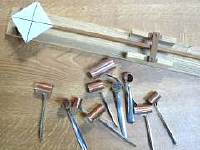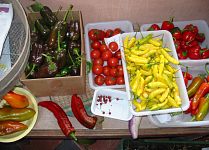Real Seed Catalogue 2007 Newsletter
 Another
summer (of sorts) has come round again already, and this year it
felt like we had hardly put away the drying racks from last autumn's
seed harvest before we were getting out the seed-sowing trays for
this springtime. Despite an invasion of fleabeetles - perhaps the
price of the warm winter and hot dry April - and now a ridiculously
wet and cold July, most things are still growing pretty well here
in the gardens, and we're enjoying taste testing lots of beautiful
new lettuces from our trials.
Another
summer (of sorts) has come round again already, and this year it
felt like we had hardly put away the drying racks from last autumn's
seed harvest before we were getting out the seed-sowing trays for
this springtime. Despite an invasion of fleabeetles - perhaps the
price of the warm winter and hot dry April - and now a ridiculously
wet and cold July, most things are still growing pretty well here
in the gardens, and we're enjoying taste testing lots of beautiful
new lettuces from our trials.
With so much in the news about climate change, and the need for action right now to stop global warming reaching dangerous levels, its nice to think that growing our own food is one of the most positive things that we can do to reduce our impact on the environment.
We are lucky in Britain to live in a reasonably mild temperate climate, and with a bit of planning most of us can be harvesting fresh food from our gardens right through the year - no need to depend on tasteless salads trucked in from Spain. With this in mind we have included a few suggestions in this newsletter for seeds to sow from now on into the autumn to keep your vegetable gardens productive all year round.
The Real Seed Collection (Ltd)
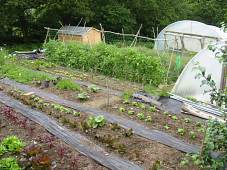
Real Seeds is well settled now in Wales, and we are glad to have two new part-time people joining us this year; Laura is now working with Cathy in the gardens and the office on Tuesdays, and Kate Squire is helping Anja out with the seed packing.
We decided it was time to improve our setup - we sorted out a seed workshop to process the seed in, expanded the gardens, and bought a fabulous new shed to store all the tools.
Now that we are a bit bigger, we decided that it was also time to sort out our legal structure as well as our gardens. We have formed a not-for-profit company limited by guarantee, called The Real Seed Collection Ltd.
We are not changing the Collection in any way, or what we do. Our aim is still to breed, maintain, research and supply the best seed possible of the best varieties there are for home gardeners, and to encourage people to save their own seed for future generations. The Company is just a tool to help us deal with the outside world . And as a company limited by guarantee rather than shares, there are no shareholders to be paid, so any surpluses made from seed sales goes straight back to support our seed trials and breeding.

A look behind the scenes . .
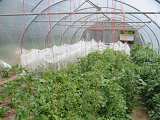
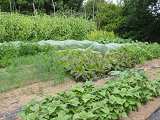
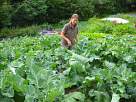 Sometimes
people think we are much bigger than we are really! Although we
try to do things really professionally, this is a small, family-run
organisation.
Sometimes
people think we are much bigger than we are really! Although we
try to do things really professionally, this is a small, family-run
organisation.
We, Ben & Kate, who started the Collection, manage things and do pretty much everything equally, although Kate does a bit more growing and Ben does a bit more more computer stuff.
We have a big polytunnel and two fields in different parts of the farm ,which lets us isolate varieties from each other so they don't cross.
Inside the polytunnel we use cages of insect-proof mesh over each variety to stop them crossing - you can see them in the photo hanging from the crop-bars .
We are helped two days a week by Cathy and Laura both in the office and in the garden - we couldn't do without them as they do pretty much everything that we haven't done yet each week - and they pack up all the seed requests that you send in.
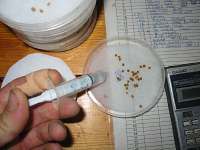

We print our own labels, and the seeds are all packed by hand, using little scoops, or counting them out, or some very accurate seed-scales we made from wood and brass.
We do test all our seed regularly - we used to be allotment gardeners and so we know that you really need to be able to depend on the seed you sow!
Because we are dealing will small numbers of packets, we can take better care of our seeds as they pass through all the stages from trial to production and packing, and we think this shows in our germination rates.
As well as all the things you find in the Catalogue each year, we actually grow many other varieties both for trial and breeding. But you'll only see those in the Catalogue once we are convinced they're really good. For example, we've been breeding a new yellow courgette for the past 6 years, and it is looking great, but won't be ready for release until 2012! So each year the gardens are a mix of trials, breeding, and production.
The Seed Ambassadors
We always spend a lot of time in winter planning what we will grow the next season and sorting through all of the interesting new seeds that we've been given to try out. This year we had an extra good selection of new seed, after we were visited by two Seed Ambassadors, Sarah Kleeger and Andrew Still.
Sarah and Andrew have been travelling around Europe (east and west) meeting seed savers and breeders. On each stop they have been collecting seeds, to then pass on to other seed growers later in their journey.
As well as their seeds, we were interested to see all their
photos and hear about all the different sorts of (often home-made)
machinery used by other small seed growers in Europe.
If you'd like to read more about their travels, Sarah and Andrew
have a website with lots of information and pictures of their
journey at www.seedambassadors.org
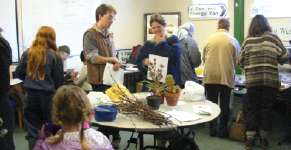 Seedsaving
Seedsaving
Those of you who watch Gardeners World may have seen a short clip of Ben being interviewed at the Machylleth Seedy Sunday seed swap last February. Its really encouraging to see the number of seed swaps taking place increasing every year. We know of at least ten different swaps now, with new ones starting up every year.
Here in Newport, Kate helped to organise the third local seed swap . We had a lovely time, drank lots of tea, talked to lots of people, and came home with some new rhubarb crowns to add to our patch (well, we have rather a lot of seeds already . . .).
If there isn't a seed swap near you, why not organise your own? All you need is a room with some tables (which could be your allotment shed, or indeed your living room), a bit of publicity, and lots of tea and cake. You can find instructions at www.seedysunday.org
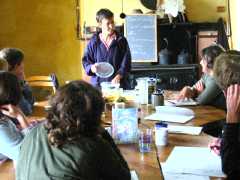 We
also enjoyed running our first weekend seedsaving course last
August. Ten enthusiastic gardeners squished tomatoes, dissassembled
flowers and hand pollinated courgettes - and hopefully will have
gone home to grow lots of seeds in their gardens this summer.
We
also enjoyed running our first weekend seedsaving course last
August. Ten enthusiastic gardeners squished tomatoes, dissassembled
flowers and hand pollinated courgettes - and hopefully will have
gone home to grow lots of seeds in their gardens this summer.
We have decided to repeat the course this year, and we've added a non-residential option for anyone local who wants to just come to the teaching sessions, or indeed for anyone who would rather stay in one of the many comfortable local B&Bs.
This year's course is on the weekend of the 11th/12th August, and costs £110 with dormitory accommodation, £95 camping, or £90 non-residential.
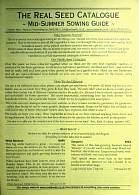
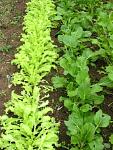 Summer
sowing
Summer
sowing
This has to be the best time of year for any vegetable grower - most of the crops in the ground, and time to start sitting back and enjoy ing eating your produce. Even so, its important not to forget to carry on sowing through the summer and into the autumn, so that you have plenty to eat from your garden all winter.
Of course there are lots of traditional over-wintering crops - parsnips, brussels, leeks, winter cabbages and cauliflowers. They are fantastic standbys, but many are in the ground from one spring right through to the next, and really take up too much space for those with smaller plots.
Even if you have limited space, there are still plenty of things to sow as your summer crops come out, that will still grow happily into the colder weather. Indeed lots of delicious vegetables, particularly the oriental greens, really do better sown in the late summer or early autumn, as they tend to bolt (run straight to flower) early in the year.
Also, if you have a polytunnel or greenhouse, it’s a real shame to leave it to stand empty over the winter. We tend to start off a whole range of salads and greens in trays outdoors in late August and early September, so that we have small plants ready to go into the tunnel as the summer crops come out. Equally, if you don't have any under cover growing space, a mini plastic or fleece tunnel will help keep off cold winds and really improve the quality and quantity of winter salad leaves.
To help those who aren't sure what they could be sowing over
the summer and into the autumn, we have put together a new Summer
Sowing Guide page on the website. Look at
http://www.realseeds.co.uk/summersowing2.html
for lots of ideas to keep your plot going through the winter
and into next spring.
New in the garden this year
Runners
We've never offered a runner bean in the catalogue, partly because we prefer to eat climbing french beans, but also partly because we've not come across a really special one that we want to include. We realised that this was a bit of a gap in the collection, and that lots of people really do like runners, so we are trialling various interesting varieties that have been passed on to us. One of them is called Jack's bean, and is reputed to grow to 12 feet or taller - so we are just waiting to see whether we will find a giant's castle at the top!
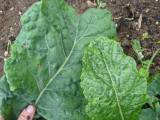
The Seed Ambassadors (mentioned above) also passed on to us a whole range of interesting new kales and cabbages from across Europe. We are trying as many as we have space for this year.
We've planted up a big bed of their Steel Green kale, which has uniquely glossy green leaves with a shiny coating which is meant to deter caterpillars. Unfortunately so far it appears to be particularly popular with flea beetles, so it may not be ideal for our conditions. (see picture right for leaf comparison)
We're also growing their True Siberian kale, which is developing very vigorously and was recommended to us as a really hardy variety to pick right through the depths of winter.
Onions
Another variety that they suggested as particularly hardy is White Spear bunching onion. We really like bunching onions; they're so easy to grow right throughout the year, and are ideal for green onions in salads and cooked dishes. They're also pretty tolerant of shade, which is helpful for us as we have trees around the edges of much of our gardens, giving us quite a few shady beds.
Achocha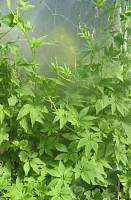 We've
always grown a good range of unusual cucurbits, with the achochas,
exploding cucumbers and various gherkins. Ben is constantly writing
to plant collectors to get new ones to try , and has unearthed
seed of two new varieties of achocha which should be much bigger
than the Fat Baby, and ideal for stuffing and baking.
We've
always grown a good range of unusual cucurbits, with the achochas,
exploding cucumbers and various gherkins. Ben is constantly writing
to plant collectors to get new ones to try , and has unearthed
seed of two new varieties of achocha which should be much bigger
than the Fat Baby, and ideal for stuffing and baking.
Like all the achochas, the plants are growing well and really seem to be happy in the Welsh climate. That's a good start, but to be honest that bit's easy - the problem though is finding ones that flower early enough to make fruit in the European climate.
We're waiting now to see if they will start to flower in mid-summer, or if they are day length sensitive and won't flower until too late in the season to be useful.
Latest news as we go topress - one of them is starting to flower, so we may well have a new day-neutral Achocha to introduce next year.
Amaranth
 Since
we don't have much time for growing flowers, we like to make sure
that we include plenty of vegetables that are beautiful as well
as tasty in our gardens. We've managed to find space this year
to bring back an old favourite; the Kerala Red leaf amaranth.
Since
we don't have much time for growing flowers, we like to make sure
that we include plenty of vegetables that are beautiful as well
as tasty in our gardens. We've managed to find space this year
to bring back an old favourite; the Kerala Red leaf amaranth.
This is a great cooked leaf vegetable, but is also the most spectacular burgundy red colour throughout, and makes fabulous dark red flowers at the end of the season too.
We're hoping that we'll manage to have seed ready early enough to include in the autumn catalogue, but if not, disasters aside it should make it onto the website later in the season.
Lettuce Trials
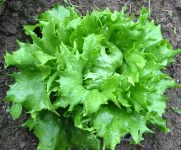
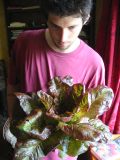
Our favourites so far have been Reine des Glaces - a green crisphead variety with amazingly crinkled leaf edges - and Devil's Tongue (modelled here by our friend Paul), which is such a deep red colour that it almost glows in the sunlight
Peppers

We've been trying a huge number of varieties that have been recommended to us over the past few years, and we're hoping to add a couple more to the catalogue this year. I'm particularly excited by Orange Bell, as it’s the first genuinely early thick walled orange sweet pepper that we've found. King of the North is a very fine sweet pepper particularly for eating green, and as its name implies is ideal for cooler and unpredictable British summers.
We are also bulking up some that did well last year. We will be releasing Kaibi - a really meaty early red pepper bred from seed that was sent to us from a tiny farm in Bulgaria - this autumn, and are hoping to have a good crop of Nigel's Outdoor Chilli, which does indeed ripen outdoors without protection.
Unusual tubers
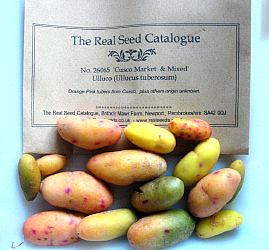
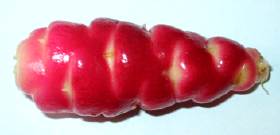 We
were amazed at how popular the oca and ulluco were last year.
We enjoy growing - and eating - unusual tubers, and it seems that
an awful lot of other people agree with us.
We
were amazed at how popular the oca and ulluco were last year.
We enjoy growing - and eating - unusual tubers, and it seems that
an awful lot of other people agree with us.
Although we thought that we had grown plenty to meet the demand, we still ran out only a few weeks after listing them on the website. So, this year we have set aside an even bigger patch, and we hope that we will have enough for everyone who wants to try them.
If you are interested, look on the website around December, as we usually harvest from late November.
There are a few other unusual tubers still on trial or being bulked up in the gardens; watch out for Yacon in a year or so, and maybe a few others yet to come.
Website - Please Order Online if you can!
As the Seed Collection has grown, we are finding it hard to get enough time to grow all the seed! One thing that is particularly slow (and incredibly boring) is reading and typing in paper order forms, so we have decided to encourage everyone who can to order online. (Online orders come straight to the computer and are ready to be packed straight away)This year we have replaced our shopping cart system with a better one, it seems quite robust and quick. We would encourage you to order online if you can.
It is the simplest, easiest web-site we can think of. No animations, no flashy gimmicks, just quick-loading pages for each type of vegetable. We have made it all very painless - and if you order online then that saves us hours trying to decipher written orders and type them in!
Paper Catalogues for now, but maybe not forever . .

For you, there are several advantages to ordering from the website: You should get your seeds quicker, as there's no need to wait for the order to get to us in the post. There is also the space for longer descriptions to include more detail about each variety, including our new sowing and harvesting calendars.
We also have a much wider range of seeds available from the website, as we can include limited stock varieties. In the paper catalogue, we can only include varieties where we definitely have enough seed to last for the entire year, whereas we can update the website several times over the season and add any new seed that is ready to go out, even if we only have a very few packets that year.Obviously, many people do like having a paper catalogue to thumb through, and not everyone has web- access. So for now we will keep the paper catalogues as well, but encourage you to order online whenever possible.
New Catalogue out in September
The new catalogue will be ready with in both virtual and paper form, around September sometime. Ben has had great fun this year tracking down old sourcebooks for typefaces, and the new cover is laid out in the style of seed catalogues from the height of non-hybrid, real vegetable breeding back in the late 1800s.
IMPORTANT - to save both your time and our time, if you ordered seed this year will be sent the new catalogue automatically when they come out, you don't need to ask for it.
About the Collection
This is a private collection of rare, heirloom, and unusual vegetables selected particularly for the home grower. All have been chosen from our personal experience, for their excellence in both the garden and the kitchen. All are non-hybrid, interesting and easy to grow, and will add new possibilities to your gardening and cooking. Our seed comes with detailed sowing instructions, recipes, and seed saving notes. Our new Real Seed Catalogue will be available in early autumn. Everyone who ordered from the last catalogue will be sent a copy of the new version when it becomes available, but if you know anyone else who would like a copy, let us know by email or post to the address below.If you like the Collection, tell your friends . . .






